Trees Birds Mammals Fish Amphibians Reptiles
Wild Algarve
Bookshop
Peziza badia Pers. : Fr. - Bay Cup
Phylum: Ascomycota - Class: Pezizomycetes - Order: Pezizales - Family: Pezizaceae
Distribution - Taxonomic History - Etymology - Identification - Culinary Notes - Reference Sources
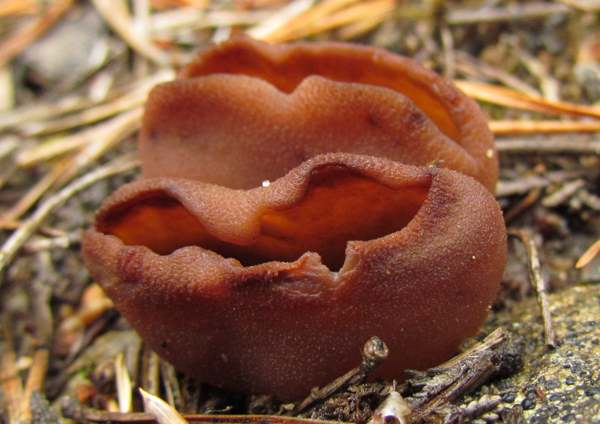
Brown cup fungi, are always difficult to identify with certainty from macroscopic characters alone; however, in most parts of Britain and Ireland the Bay Cup is the most commonly encountered member of this genus, and that increases the likelihood of it being identified correctly. These long-lasting fruitbodies are fascinating: if you drop a few grains of sand into a mature cup, a visible cloud of spores will be releaseed... unless someone else (a passing animal for example) has rushed by recently and triggered a spore release.
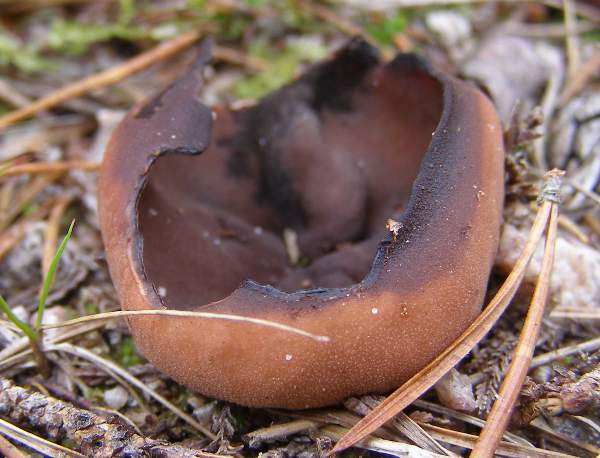
As dry sand or other fine debris is blown across the open cups by strong winds, particles inevitably fall into the cups, and this triggers the discharge of ripe ascospores; these tiny spores are then carried away on the breeze – quite a cunning system for releasing spores at times ideal for their long-range distribution!
Distribution
Widespread and common in Britain and Ireland as well as in mainland Europe and temperate parts of Asia, Peziza badia is also reported from many other parts of the world including North America.
The Bay Cup fungi shown here are fully mature, and their inner surfaces in particular are much darker than they are in the immature specimens shown above. Eventually the whole fruitbody turns dark brown or black before gradually disintegrating from the rim downwards.
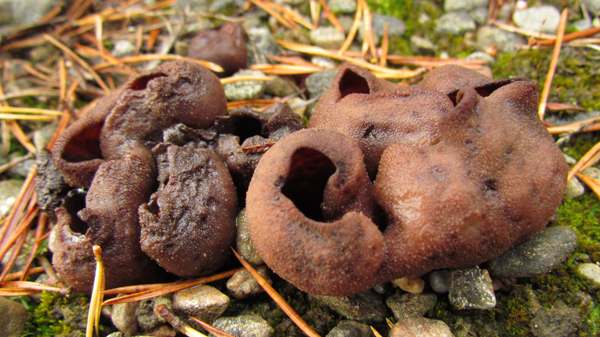
Because Bay Cups are slow to decay, they turn up on fungus forays throughout the summer and autumn and well in to winter; however, the real challengs is to find perfect specimens, and these are far less common.
Taxonomic history
The Bay Cup was described in 1801 by Christiaan Hendrick Persoon, who gave it the scientific name that is generally accepted to day.
Synonyms of Peziza badia include Helvella cochleata Bolton, Scodellina badia (Pers.) Gray, and Galactinia badia (Pers.) Fr.
Etymology
Peziza, the genus name, may come from a Latin root referring to a foot - most fungi in this group being sessile (footless or stemless). The specific epithet badia means bay (reddish) brown.
Identification guide
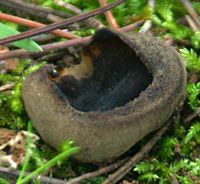 |
Description
2 to 8cm across and 1.5 to 4cm tall; cup-shaped with an inturned margin initlally, opening into an expanding circular or eliptical cup with a rim that becomes irregular and wavy when fully developed. Outer (infertile) surface is various shades of bay brown and finely scurfy; the inner (hymenial or fertile) surface is smooth and often a slightly darker shade of bay brown, sometimes with an olive tint. The Bay Cup is sessile - it has no stem. |
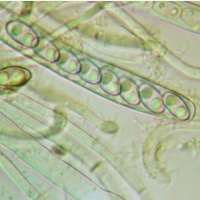 |
Asci
300-330 x 15μm; eight spores per ascus; asci amyloid (tips turn blue in Melzer's Reagent).
|
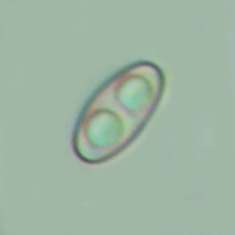 |
Spores
Ellipsoidal, 17-20 x 9-12μm; ornamented with an irregular reticule (net pattern).
Spore print
White. |
Odour/taste |
Not distinctive. |
Habitat & Ecological role |
The Bay Cup is saprobic and occurs on compacted heavy soils, particularly forest footpaths; often among gravel or shale. |
Season |
June to November in Britain and Ireland. |
Similar species |
There are at least 100 Peziza species and most are various shades of fawn or brown. Definite identification is rarely possible without microscopic examination. |
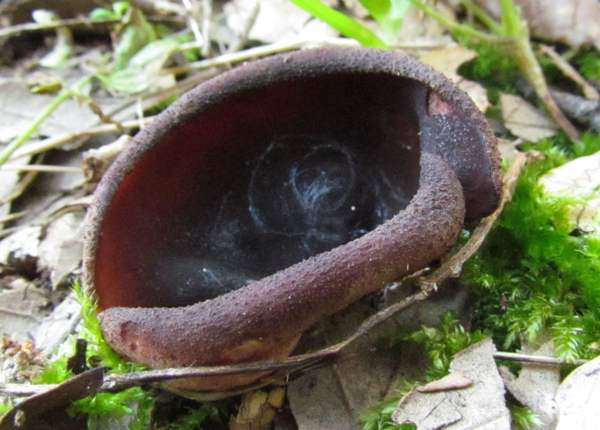
Culinary Notes
Although generally considered to be edible provided it has been thoroughly cooked, the Bay Cup Peziza badia is not highly rated as an esculent. This cup fungus is poisonous if eaten raw or inadequately cooked, when it can cause seriously unpleasant stomach upsets. (The same is true of most edible ascomycetes including Morchella esculenta, the Morel, and Morchella elata, the Black Morel.)
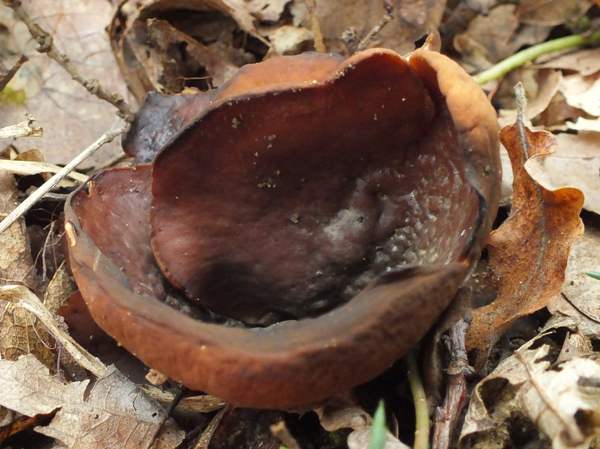
Reference Sources
Fascinated by Fungi, 2nd Edition, Pat O'Reilly 2016, reprinted by Coch-y-bonddu Books in 2022.
British Mycological Society, English Names for Fungi
Dennis, R.W.G. (1981). British Ascomycetes; Lubrecht & Cramer; ISBN: 3768205525.
Breitenbach, J. & Kränzlin, F. (1984). Fungi of Switzerland. Volume 1: Ascomycetes. Verlag Mykologia: Luzern, Switzerland.
Medardi, G. (2006). Ascomiceti d'Italia. Centro Studi Micologici: Trento.
Donadini J.C. 1981. Le genre Peziza dans le sud-est de la France, avec clef du genre pour la France; Universite d'Aix-Marseille
Dictionary of the Fungi; Paul M. Kirk, Paul F. Cannon, David W. Minter and J. A. Stalpers; CABI, 2008
Taxonomic history and synonym information on these pages is drawn from many sources but in particular from the British Mycological Society's GB Checklist of Fungi.
Top of page...
Fascinated by Fungi. Back by popular demand, Pat O'Reilly's best-selling 450-page hardback book is available now. The latest second edition was republished with a sparkling new cover design in September 2022 by Coch-y-Bonddu Books. Full details and copies are available from the publisher's online bookshop...